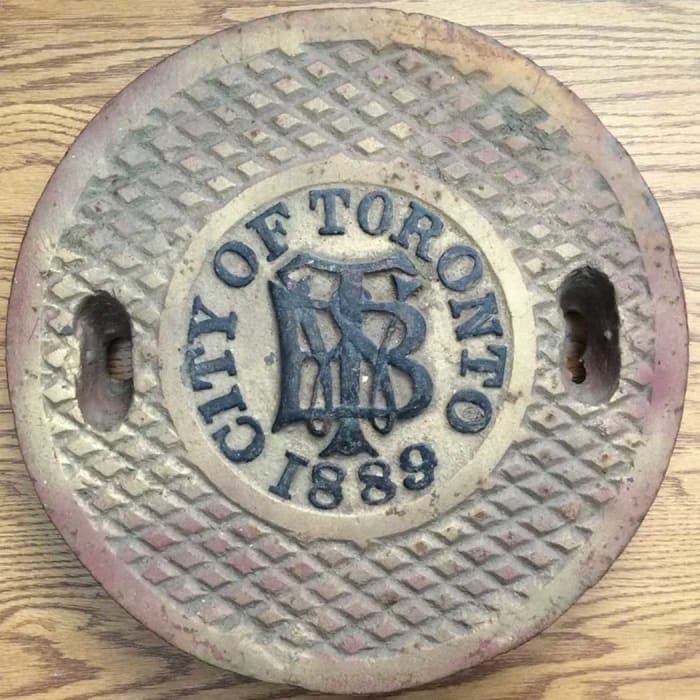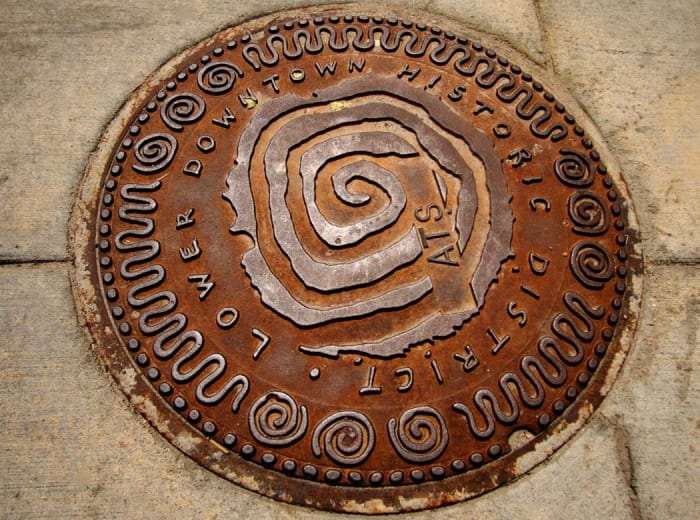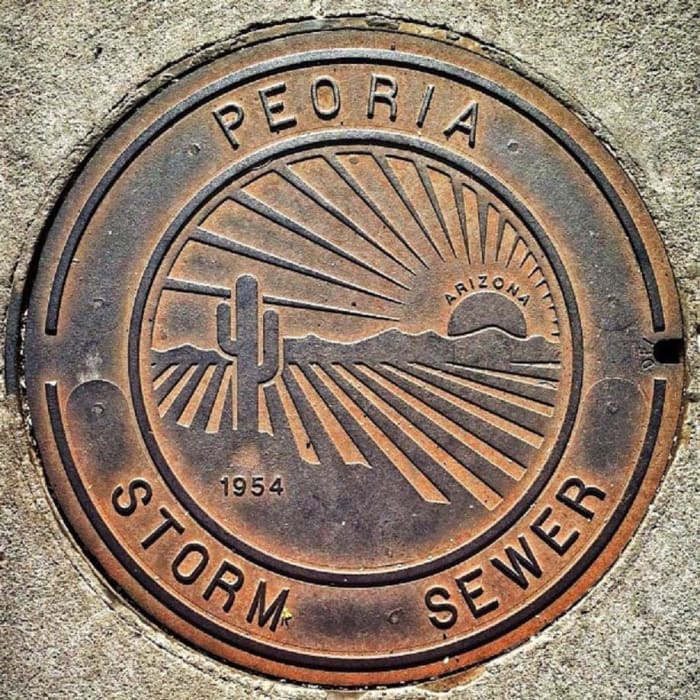#Collecting #Manhole #Covers
Manhole covers are not often seen as collectibles, especially due to their weight – 150 to 250 pounds. Most manhole covers in the U.S. were made of cast iron leaving them inexpensive to manufacture; sturdy enough to hold up to constant traffic and heavy enough to deter most, but not all, thieves from absconding with them to sell for scrap.
The earliest manhole covers were stone slabs or pieces of wood that afforded entry to enclosed ditches that transported sewage. This rudimentary model was utilized beginning from 3500 BC up to as late as the 1850s. From that point on modern manholes were used. Markings on manhole covers may designate which type of facilities exist below, be it a local water system or a natural gas firm or other service.
Although too cumbersome for most collectors, the varying designs and words embossed on manhole covers have prompted people to collect pictures of these examples of urban art, not just from the United States but from around the world also. But some collectors are not satisfied with simply a photograph: they want the real thing.
Manhole covers can be found on eBay and other online auction sites. Sellers on eBay are offering a number of vintage manhole covers in the range of $400 to $1,000. Etsy has a number for sale; one was listed as high as high as $1,644. Sotheby’s even sold a manhole cover from Chandigarh, India, for more than $10,000.
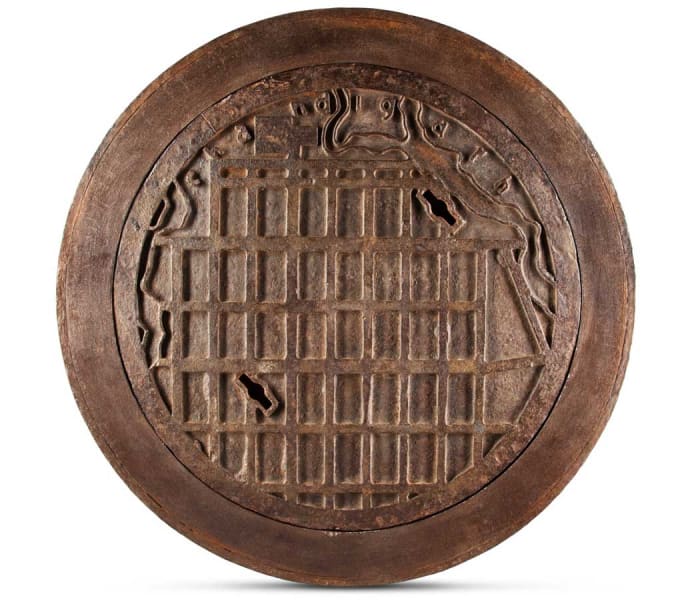
A manhole cover from Chandigarh, India, in the foothills of the Himalayas, sold for more than $10,000 at Sotheby’s. Noted Swiss architect and city planner Le Corbusier served as architectural advisor for the construction of the city, helping to make everything about it, including its manhole covers, fascinating.
Courtesy Sotheby’s
Most manhole covers are round. But why?
There are several reasons: a circular cover of a certain diameter has far less surface area than that of a square cover of the same width. This translates into less material needed to cast the manhole cover, thus less expensive to make; the surfaces of manhole covers and frames are fabricated in such a manner that they remain flat and do not become dislodged by traffic traveling over them; round manhole covers need not be rotated to fit snugly over the manhole; some covers are lockable requiring a special tool to remove them; and once removed, a round manhole lid can be moved by rolling it away. Try doing that with a heavy square shaped piece of cast iron.
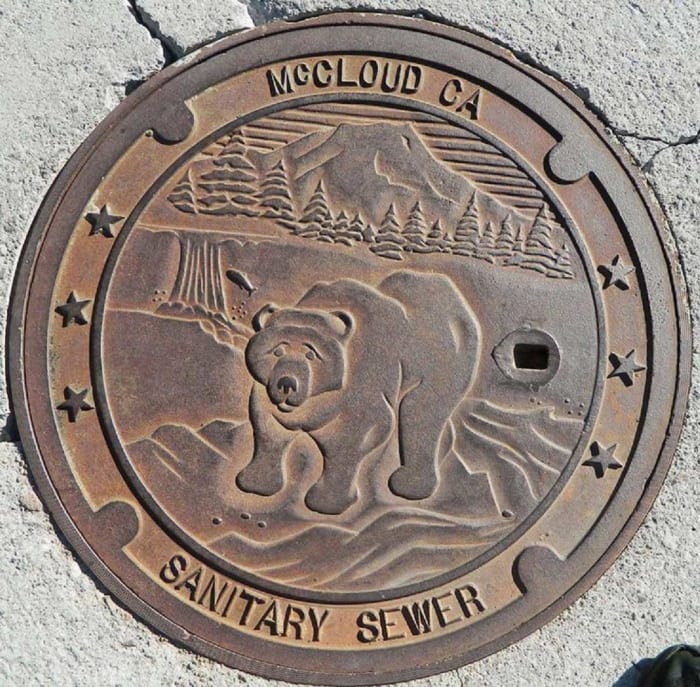
McCloud, California, is nestled at the base of Mt. Shasta, which is featured on its manhole cover, along with a California grizzly bear, the official state animal.
The theft of manhole covers can have serious consequences. When scrap metal prices increase so, seemingly, does the rate of theft for manhole covers. In China in 2004 stolen manhole covers resulted in at least eight deaths. That same year in Newham, East London, close to 200 grates and covers were pinched. Again, that same year, in Kolkata, India, in excess of 10,000 manhole covers were stolen within a two-month period. Closer to home and more recent, thirty manhole covers were taken in a single December day in 2021, from streets in Chatham County, Georgia.
RELATED: Connecticut’s Merritt Parkway Bridges
The Japanese have elevated the black metal manhole covers to the status of colorful original works of art. These are certainly original as Japan currently has 6,000 dissimilar designs distributed throughout the country. Where the plain black manhole lids cost around $500 each to produce, the specialty covers can run as high as $3,000. But the Japanese believe this is well worth the extra cost as they elevate the image of the sewer system. People from across Japan travel to see the different designs in a movement lovingly called ‘drainspotting.’ In this craze, you’ll see fans clamoring to see and visit as many manhole cover designs as possible. Of course, there are many souvenirs, memorabilia, T-shirts, and collectibles related to all this. You can even claim the absolute Japanese Manhole Nerd title by attending Japan’s Manhole Festival in Tokyo.
Although round covers have been the way to go in the majority of municipalities, early on Nashua, New Hampshire, opted for triangular shaped covers. These odd shaped lids were built in the 1920s or 1930s by Nashua Foundry. Numbering in the thousands, the covers were put in place throughout the city. They were the brainchild of Walter Ellis an engineer. Ellis’s reasoning for the triangular shape was twofold: they would clatter less than the circular ones when vehicles rode over them; and secondly, the tip of the triangles pointed the direction of flow for the sewer line below. This proved to be important for utility workers tracking problems. But because of the geometry of the shapes, the triangle equals only half the area of the round covers, making them too small by present day safety requirements. To rectify the problem Nashua has been swapping out the old covers with new round ones.
Municipalities take pride in their manhole covers, using them to publicize highlights of their cities. One example is Peoria, Arizona; it sports a cactus and the sun on its manhole covers; another one, Erie, Pennsylvania’s manhole covers are exceedingly detailed with historical illustrations. Still another example is McCloud, California. It is set in the northern part of California and is situated at the base of Mt. Shasta. Mt Shasta is featured on the city’s manhole cover.
Sources:
Alter, Cathy, “History right under our feet’: Decorative manhole covers are a window
on Washington’s past,” July 11, 2018. The Washington Post.
Brooks, David, “Historic and unique, Nashua’s triangular manhole covers are being replaced because they’re too small,” August 21, 2011.
“Manhole Covers Around the World,” www.sewerhistory.org
Schmalzbach, Jonathan, “From Prints to Trivets, Art Imitates Life Of Manhole Covers,”
January 11, 2018. www.hiddencityphila.org
“Street art: Japanese manhole covers,” May 17, 2019. www.cbsnews.com
Young, Michelle, “10 of NYC’s Most Unique and Artistic Manhole Covers.” www.untappedcities.com
“Walking on History: Surprising Secrets of Man-holes,” June 3, 2021. www.heritagecalling.com
You May Also Like:
Vintage Door Knockers Earn No-Bell Prize

